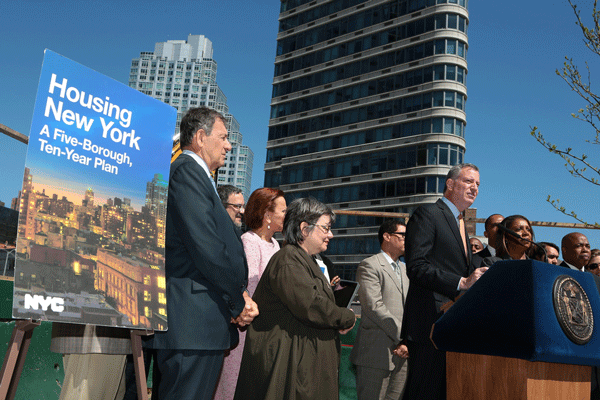
At an affordable housing construction site in Fort Greene, Mayor Bill de Blasio announces the bold goals of “Housing New York: A Five-Borough, Ten-Year Plan.”
BY ANDREW BERMAN (Executive Director, Greenwich Village Society for Historic Preservation) | Mayor de Blasio’s twin rezoning proposals to reshape development in our city go before the City Council for a final vote in March. The plans purport that letting developers build taller buildings will result in their including more affordable units, and that vastly increasing the number of new market-rate housing units we build, even while building a much smaller number of affordable units, will make our city and our neighborhoods more affordable.
But the facts just don’t bear this out.
The mayor’s “Mandatory Inclusionary Housing” (MIH) proposal would require 25-30% of new residential developments in certain areas to be affordable. There’s a catch, though. The requirement would only be applied when the city changes zoning rules to vastly increase the amount of new market-rate housing that could also be built. Thus, affordable housing is only provided if a great deal more market-rate housing is also built than would otherwise be allowed.
Sound familiar? This is the formula used 10 years ago in Manhattan’s West Chelsea/Hudson Yards neighborhoods, as well as in Brooklyn’s Williamsburg/Greenpoint neighborhoods. Zoning rules were changed to significantly increase the allowable amount of residential development, with strong incentives for making a fraction of the housing affordable.
The result? Quite a bit of affordable housing was built in both areas — more than in any other part of the city, or about 25% of new units on the West Side and 16% in Williamsburg/Greenpoint. But there was also a virtual tsunami of new market-rate housing that utterly transformed those neighborhoods, physically and socio-economically. These formerly diverse areas became among our city’s least affordable and most rapidly gentrifying neighborhoods, defined by walls of glassy high-rises that resemble Hong Kong or Miami more than New York.
This is the model the mayor is seeking to apply across the city. But there’s a less discussed, more pernicious flip side to linking these affordable housing requirements exclusively to massive upzonings. Neighborhoods unwilling to accept vastly increased amounts of market-rate housing get no affordable housing. Case in point: The de Blasio administration has consistently rejected a rezoning proposal for the University Place/Broadway corridor in Greenwich Village with an affordable housing component, because we were unwilling to accept a vast increase in the allowable amount of market-rate housing along with it.
The mayor’s other rezoning proposal, “Zoning for Quality and Affordability” (ZQA), would lift height limits by over 30% in certain parts of the city when new developments include 20% affordable housing. Some might find this a worthwhile trade-off, if it results in more affordable housing.
Problem is, it won’t.
This part of the mayor’s plan would apply to areas called “Inclusionary Zones” that currently have strong incentives for including affordable units in new developments. According to the city’s own study, in 95% of the cases, they already do. But the city claims existing height limits prevent a higher rate of inclusion — that the caps don’t leave room to “fit” the affordable units, so developers leave them out.
Here, again, studies say something different. The affordable housing program’s complicated bureaucracy and requirements, comparatively generous tax breaks for building market-rate rather than affordable housing, and the relative inexperience of smaller builders seem to be the main reasons some developments don’t include the affordable units. Unfortunately, the mayor’s rezoning plan would do nothing to address these factors, which actually do inhibit the inclusion of affordable housing in new developments.
The mayor’s rezoning proposals create a false dichotomy, claiming if we just allowed more and larger developments, we’d have a more affordable city. At best, evidence indicates the height-lifting approach of ZQA would result in no net increase in affordable housing. At worst, experience shows MIHs vast increases in market-rate housing would likely accelerate gentrification and inflate rents and housing prices.
Either way, these plans will undeniably make for more crowded, less livable communities, with services and infrastructure stretched ever thinner. Worse, such approaches divert us from implementing real solutions to New York’s affordability problems.
Our neighborhoods, and our city, deserve better.


































